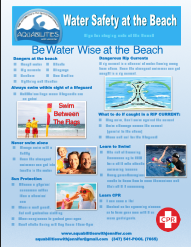
Be Water Wise at the Beach
Going to the beach is a fun and exciting activity, but it's important to remember that water safety should always be a top priority. Before heading out, make sure to check the weather and water conditions, and always swim in designated areas with
a lifeguard on duty. Remember to never swim alone, and keep a close eye on children at all times. By following these
simple tips, you can a safe and enjoyable day at the beach.
Quick Safety Tips
-
Swim near a lifeguard whenever possible. If you do not see a lifeguard you should avoid swimming.
-
Check the flags and signs — they provide up-to-date safety information.
-
Never swim alone or at night.
-
Know your limits – if you're not a strong swimmer, stay in shallow areas. Even strong swimmers have a hard time with currents.
-
Keep a close watch on children at all times. NEVER leave your child unattended at the beach.
-
Avoid alcohol before or during swimming.
-
Stay hydrated and protect your skin from the sun. If you are feeling light headed you should find a cool shady space.
-
Don't turn your back on the ocean – waves can knock you down unexpectedly.
-
Learn how to spot rip currents (more below).
-
Call for help immediately if someone is in distress – do not attempt a solo rescue unless you are trained for beach water rescues.
Identifying Beach Hazards
The ocean is dynamic and conditions can change rapidly. Recognizing hazards can help you avoid dangerous situations:
Rip Currents
These narrow, fast-moving channels of water flow away from the shore. They can pull even strong swimmers out to deeper water quickly.
How to Spot One:
-
Water that looks darker and calmer between breaking waves
-
Fewer breaking waves in a specific area
-
A noticeable difference in water color
-
Seafoam, debris, or sand being pulled away from shore
Other Hazards
-
Shorebreaks: Steep waves that crash directly on the sand — can cause injuries.
-
Marine life: Jellyfish, stingrays, and other creatures can pose a threat. Shuffle your feet in the sand to avoid stepping on stingrays.
-
Strong surf or undertow: Even when waves appear manageable, the underlying force can be powerful.
-
Sudden weather changes: Lightning and storms can roll in quickly — leave the water immediately if you see lightning or hear thunder.
-
Stranger danger: the beach can get very crowded and it is a large area. Always watch your kids and keep them within reach.
How to Escape a Rip Current
If you find yourself being pulled away from shore, don’t panic. Staying calm is key to survival.
Here’s what to do:
-
Don’t fight the current. Trying to swim straight back to shore will exhaust you.
-
Swim parallel to the shore. Rip currents are usually narrow — swimming along the shoreline gets you out of the flow.
-
Once free of the current, swim back to shore at an angle, away from the rip.
-
If you can’t escape, float or tread water calmly and wave for help.
-
Conserve energy and keep your head above water. Help is more likely to reach you if you’re visible.
Tip: Most rip currents weaken just beyond the breaking waves, so don’t panic if you're pulled out — focus on staying afloat and signaling for help.
Emergency Contact
In case of emergency:
-
Call 911 or alert a lifeguard immediately.
Have a basic understanding of CPR and rescue breathing before heading to the beach.


